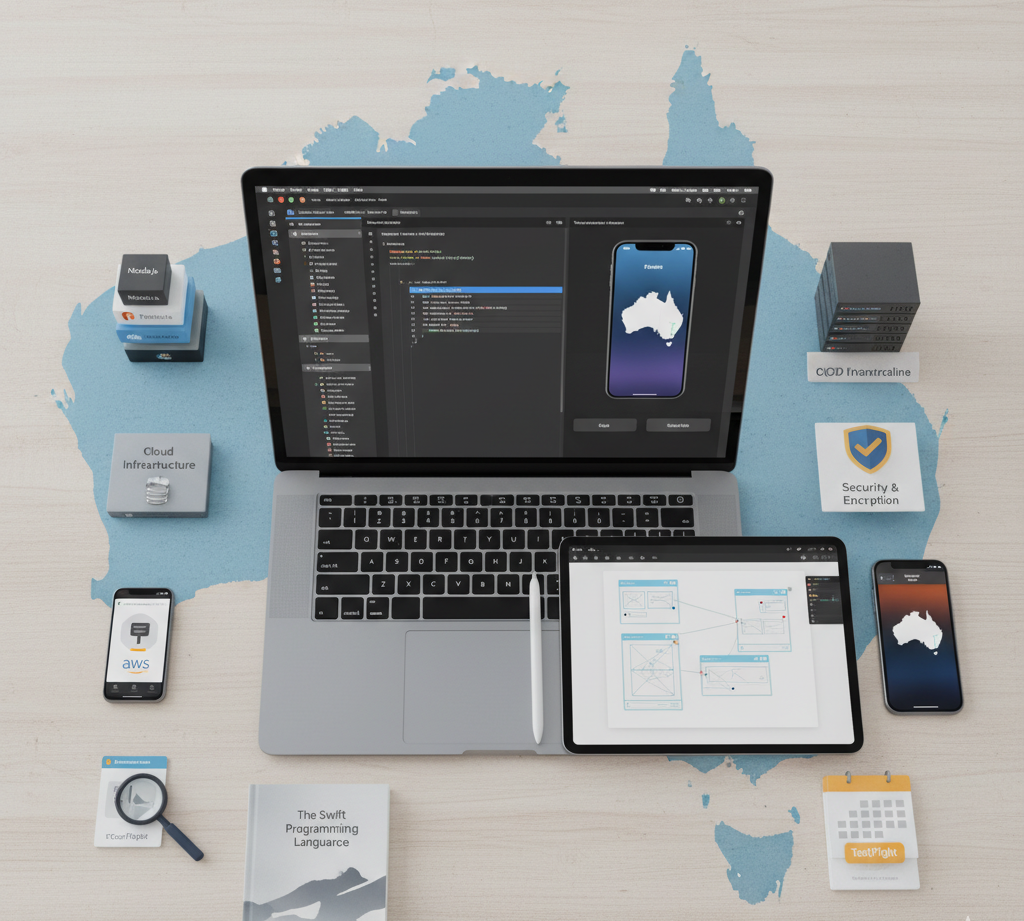The demand for iOS applications in Australia has grown significantly in recent years, driven by the proliferation of Apple devices and the increasing reliance of businesses on mobile technology. From startups to large enterprises, organizations seek high-quality iOS apps to engage customers, streamline operations, and enhance brand visibility. Building a successful iOS app requires more than just coding skills; it demands familiarity with the right development tools, frameworks, and technologies to ensure performance, security, and scalability. In this article, we explore the essential tools and technologies for iOS app development in Australia, helping businesses and developers make informed decisions for successful mobile app launches.
The Importance of iOS App Development in the Australian Market
Australia boasts a high penetration of Apple devices, including iPhones, iPads, and Apple Watches, making it a lucrative market for iOS app development. Businesses that invest in iOS apps can reach a premium audience that values quality, security, and user experience. Additionally, the App Store’s global reach enables Australian businesses to expand internationally with minimal friction. With Apple’s strict guidelines and emphasis on performance, choosing the right tools and technologies ensures that apps are compliant, responsive, and capable of delivering seamless user experiences. Understanding the iOS ecosystem is critical to building apps that resonate with users and achieve measurable business outcomes.
Key Considerations for Selecting iOS Development Tools
Compatibility and Ecosystem
Selecting tools that integrate seamlessly with the Apple ecosystem, including macOS, iOS, iPadOS, and watchOS, ensures smooth development and testing processes. Tools should support the latest SDKs and be compatible with Xcode and Apple’s design guidelines. This compatibility reduces development time, minimizes errors, and guarantees adherence to platform standards, leading to apps that perform optimally on all Apple devices.
Ease of Use and Learning Curve
Development tools must balance functionality with usability. Tools with steep learning curves can slow down the development process, particularly for small teams or startups. Prioritizing intuitive tools that provide documentation, tutorials, and community support ensures developers can focus on building features rather than troubleshooting software.
Scalability and Flexibility
Apps should be designed to scale as user demand grows. Selecting technologies that support modular architectures, reusable components, and seamless integration with third-party APIs ensures long-term maintainability. Scalable tools also facilitate updates, new feature integrations, and performance enhancements without requiring complete redevelopment.
Security Features
Given the sensitivity of user data, security is paramount in iOS app development. Development tools should include support for encryption, secure authentication, and compliance with privacy standards such as GDPR and Australian privacy laws. Secure tools reduce the risk of breaches and protect both user information and business reputation.
Core Programming Languages for Building Robust iOS Apps
- Swift: Swift is Apple’s official programming language for iOS development, designed to be safe, fast, and expressive. Its syntax is beginner-friendly yet powerful, enabling developers to build feature-rich apps efficiently. Swift supports modern programming paradigms such as object-oriented and protocol-oriented programming, enhancing code reusability and maintainability. Its strong type system and error handling reduce runtime crashes, making apps more reliable and performant.
- Objective-C: While Swift has become the preferred language, Objective-C remains relevant for maintaining legacy applications and integrating with older libraries. It offers dynamic runtime capabilities and robust performance for complex applications. Objective-C is often used in conjunction with Swift for hybrid projects, ensuring smooth migration and compatibility with existing codebases. Understanding Objective-C is advantageous for developers maintaining long-term enterprise applications.
Integrated Development Environment (IDE): The Essential Toolkit
Xcode: Xcode is Apple’s official IDE for iOS, iPadOS, macOS, watchOS, and tvOS development. It provides a complete toolkit, including a code editor, interface builder, debugger, and simulator. With Xcode, developers can design UI visually, write Swift or Objective-C code, and test applications in real time on multiple virtual devices. Its integration with Git, CocoaPods, and continuous integration tools streamlines collaboration among development teams. Xcode’s compatibility with the latest Apple SDKs ensures apps leverage the newest iOS features and performance improvements.
UI/UX Design Tools for Exceptional iOS App Experiences
- Sketch: Sketch is a vector-based design tool widely used for creating user interfaces for iOS apps. It allows designers to create scalable and pixel-perfect designs, interactive prototypes, and design systems. Its plugin ecosystem enables seamless integration with development workflows, reducing handoff friction between designers and developers.
- Figma: Figma offers cloud-based collaborative design, making it ideal for distributed teams. Designers can create interactive prototypes, share feedback in real time, and maintain consistency across app screens. Its cross-platform support ensures seamless collaboration between Mac and Windows users, enhancing productivity in Australian development teams.
- Adobe XD: Adobe XD combines design and prototyping in one tool. Developers can export assets directly from XD into Xcode, streamlining the development pipeline. Its animation and interactive features help create engaging user experiences, crucial for iOS apps targeting competitive markets.
Backend Development Tools for Scalable Mobile Solutions
- Node.js: Node.js provides a lightweight, scalable, and high-performance backend for iOS apps. Its event-driven architecture makes it ideal for real-time applications such as chat, notifications, and live updates. Node.js supports RESTful APIs, microservices architecture, and integration with cloud databases, enhancing app scalability.
- Firebase: Firebase is a Google-owned backend platform offering real-time databases, authentication, cloud storage, and analytics. Its pre-built modules accelerate development by reducing the need for custom backend coding. Firebase also integrates seamlessly with iOS apps, supporting push notifications, crash reporting, and user engagement tracking.
- AWS (Amazon Web Services): AWS provides cloud-based infrastructure for scalable backend solutions. Services like EC2, S3, and Lambda enable reliable storage, serverless computing, and secure data processing. AWS ensures high availability, fault tolerance, and compliance with global security standards, making it ideal for enterprise-grade iOS apps.
Essential Libraries and Frameworks for Efficient Development
- Alamofire: Alamofire is a Swift-based networking library that simplifies API requests, response handling, and error management. It supports RESTful API integration and JSON parsing, reducing boilerplate code and accelerating development.
- Realm: Realm is a mobile database framework optimized for iOS, offering fast local storage, real-time syncing, and easy integration with Swift. Its lightweight architecture ensures smooth app performance even with large datasets.
- Core Data: Core Data is Apple’s native framework for data persistence. It allows developers to manage object graphs and handle complex data relationships efficiently. Core Data integrates seamlessly with Xcode and Swift, ensuring optimal performance for iOS applications.
Testing & Quality Assurance Tools to Ensure Reliability
- XCTest: XCTest is Apple’s testing framework for unit tests, performance tests, and UI testing. It integrates directly with Xcode, allowing developers to automate test cases and ensure high-quality, bug-free applications.
- TestFlight: TestFlight enables beta testing of iOS applications before public release. Developers can distribute pre-release builds to testers, gather feedback, and identify issues early. This process improves app stability and ensures a smooth user experience.
- Appium: Appium is an open-source testing tool supporting cross-platform automation. It allows testing of iOS apps on multiple devices and OS versions, ensuring comprehensive quality assurance.
Version Control & Collaboration Tools for Team Productivity
GitHub / GitLab / Bitbucket: Version control is essential for collaborative development. Tools like GitHub, GitLab, and Bitbucket allow developers to track changes, manage branches, and collaborate on code effectively. Integration with CI/CD pipelines ensures automated builds, testing, and deployment, reducing errors and enhancing productivity.
Analytics & Monitoring Tools for Data-Driven Decisions
- Google Analytics for Firebase: Provides insights into user behavior, engagement, and retention. Businesses can make data-driven decisions to improve app performance and optimize user experience.
- Crashlytics: Crashlytics is part of Firebase and offers real-time crash reporting. It helps developers identify issues quickly, prioritize fixes, and maintain app reliability.
- Mixpanel: Mixpanel provides advanced analytics for user flows, feature adoption, and conversion tracking. It enables targeted engagement strategies, increasing retention and app monetization potential.
Critical Security Tools & Best Practices
- SSL/TLS Encryption – Secures data in transit.
- OAuth 2.0 & JWT Authentication – Protects user accounts and API access.
- Biometric Authentication – Integrates Face ID and Touch ID for enhanced security.
- Penetration Testing Tools (OWASP, Burp Suite) – Identifies vulnerabilities before launch.
Security is critical for iOS apps handling sensitive user data, particularly in finance, health, or enterprise applications. Incorporating these tools ensures compliance with privacy regulations and protects user trust.
Conclusion
Developing a high-quality iOS app in Australia requires careful selection and mastery of the right tools and technologies to ensure performance, scalability, and security. From the foundational programming language Swift and the comprehensive IDE Xcode, to collaborative design tools like Figma and robust backend solutions like AWS, every choice is critical for a successful mobile launch. By leveraging these essential tools and partnering with an experienced company like Dev Story, businesses can successfully create iOS applications that engage users, drive growth, and deliver measurable outcomes in a competitive Australian and global market.

